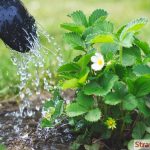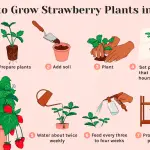To water a garden without running water, you can use alternative methods such as collecting rainwater or using water from a nearby stream or well. These methods provide a sustainable and eco-friendly solution for watering your garden without relying on traditional water sources. Besides some unique ways, you can do watering by-
- Rain Barrel
- String Drip System
- Watering Planter
- Oya or Ollas
- Bucket Brigade
- Watering Can
- Greywater Recycling
- Soaker Hoses
Besides these methods, root watering and hydrogel crystals can be mixed into the soil to help retain moisture and slowly release it to plant roots.
You can adopt these practices to water your garden without a hose pipe or running water. In fact, 100% of USA gardeners are using these techniques along with hose pipe systems.
Adopting these practices, you can ensure that your garden flourishes while reducing your dependence on running water.
How to gauge garden water needs without running water?
Though regular watering in your garden is important, assessing water needs for a garden without running water involves considering various factors.
These factors include calculating the water requirements for different types of plants.
Generally, it is termed by evapotranspiration rate which deploys as 20 mm/day, 450 mm/month, or 1500 mm/season. Though it’s a technical term, you don’t need to follow these.
Just keep in mind the plant nature and watering frequently is enough.
Each plant has unique water needs, so understanding the importance of proper watering is vital for their growth and health.
You can determine how much water it requires by evaluating the plant’s size, species, growth stage, and environmental conditions.
Without running water, alternative water sources like rainwater or stored water become important.
Conservation methods such as mulching and using efficient irrigation techniques can also play a significant role in watering your garden.

Top 6 Alternative Water Sources You Can Try-
Watering a garden without running water can be achieved through alternative water sources. Here are some of the details explanations, of how you can use it in your garden-
Rainwater Harvesting:
In my perspective, one effective technique is rainwater harvesting, where you collect rainwater to use for irrigation.
It will help you to reduce the reliance on traditional water sources and conserve water.
As per the data we collected, it refers about rainwater harvesting systems can capture up to 80% of the rainwater that falls on a catchment area.
Besides that, 30 to 50 percent of the total water is used for landscape irrigation if you correctly collect and store it.
It is estimated that every 1 inch of rain and 1,000 square feet of impermeable surface yields approximately 620 gallons of water which is equivalent to about 0.62 gallons per square foot.
You can simply use rainwater by barrel, Here is how-
A rain barrel can placed under the shade around the home.
After the precipitation, the water will collect through the downspout movement by gravity and stored on the barrel.
Then you should use a soaker hose to connect watering activity with your planting system.
If the rainfall is enough then, you may not even need any external source of water. However, this will also depend on how many garden beds or plants you have.

Hand Watering by Watering Can
When it comes to nurturing your garden or plants with care and precision, hand watering using a watering can emerge as a simple yet efficient method.
Watering cans are portable containers with a handle and funnel that can hold between 0.5 and 10 liters of water
No laborious job, no extra cost, or even no tension to over or underwater to the plant.
This manual approach allows you to be in direct control of the water distribution, ensuring each plant receives the attention it deserves.
| Advantages of Hand Watering | Disadvantages of Hand Watering |
| Water plants individually based on their needs. | Dragging a hose can be a hassle. |
| Apply water directly to the ground, not over the top. | Inconsistent water amounts when in a hurry. |
| Stop watering when adequate irrigation is achieved. | |
| Target only the areas needing water, conserving water. |
String Drip System
A string drip system, also known as a “wick” or “rope” irrigation system, is a simple and effective method of delivering water directly to the root zone of plants.
This approach is particularly useful in situations where access to running water is limited.
It is especially beneficial for container gardening or small garden plots.
Here’s how a string drip system works and why it can be a valuable watering solution:
Principle of Capillary Action:
The string drip system operates on the principle of capillary action, where water naturally moves upward through a porous material, such as a string or rope.
The process is running due to the forces of cohesion and adhesion.
As water moves through the material, it reaches the plants’ roots, ensuring efficient hydration.
However, to set up a string drip system, you’ll need a water source, a container, or a reservoir for water, a length of absorbent string or rope, and a way to secure the string to the water source and the plant container.
Setup Process:
Place one end of the string in a water container or reservoir. This container can be elevated to create a gravity flow of water.
Bury the other end of the string in the soil near the plant’s root zone. Make sure the buried end is close to the plant’s roots but not too close to avoid waterlogging.
Secure the string to the water container and the plant container to keep it in place.
This is the method by which you can water your plant in your absence for a long time.

Greywater Recycling
Greywater recycling is the practice of reusing wastewater from domestic activities like laundry, bathing, and dishwashing for irrigation and other non-potable purposes.
Greywater, which is relatively less contaminated than blackwater (sewage), can be treated and repurposed, conserving fresh water and benefiting the environment.
Here’s an overview of greywater recycling:
Treatment:
Depending on local regulations and your specific needs, you may choose to treat the greywater before reuse.
Treatment methods can include filtration, settling tanks, and biological processes to remove contaminants.
Storage and distribution:
Greywater is stored in a separate tank or container, often connected to a distribution system for use in irrigation.
It can be distributed to your garden or landscape through subsurface irrigation, drip systems, soaker hoses, or other suitable methods.
You should provide water directly to plant root zones, minimizing wastage and improving water efficiency.
Bucket Brigade method
The Bucket Brigade method of watering is a manual and labor-intensive approach.
However, it will hydrate your garden or plants when you don’t have access to running water.
It involves a team effort to manually transport water from a source to the plants that need it.
First of all, if your garden is situated near a suitable water source, such as a well, river, pond, or water storage tank, It will be easy for you.
As the distance increases, the process will much costly and labourious. In this way, you can choose another method to do the same task equally.
The term, forms a line or “brigade” with the participants, passing the filled containers from one person to the next in a systematic manner.
Plastic Bottle Drip System
If you don’t like or have such a workforce to do the above method, then Plastic Bottle Drip System is for you.
It is an innovative and low-cost method of providing consistent irrigation to plants, particularly in areas where water resources are limited
This system repurposes plastic bottles to create a slow and controlled release of water directly to the plant roots.
Materials Needed:
- Plastic bottles (e.g., 1-liter or 2-liter soda bottles)
- Water source
- Soil
- Plants
Setup Process:
You should clean and rinse the plastic bottles thoroughly to remove any residue.
Then try to use a sharp tool or drill, to create small holes in the bottle cap or along the sides near the bottom.
These tiny holes will allow water to slowly drip out.
Now, fill the plastic bottle with water from the water source. (If you want, then you can add fertilizer with water.)
After doing that, dig a small hole in the soil near the base of the plant you want to water. Be careful about damaging the plant roots.
Invert the plastic bottle and bury it neck-first in the hole, ensuring that the holes in the cap or sides are positioned near the plant’s root zone.
How can water conservation strategies be effectively implemented?
An accurate water conservation strategy is vital for gardeners who don’t have access to running water.
It will help you to minimize water usage and still keep your garden thriving. One effective approach is soil moisture management, which helps prevent water evaporation.
Keeping the soil damp but not soaked ensures that plants receive adequate hydration without waste.
Another vital and widely accepted method is mulching, which helps conserve moisture in the soil by reducing evaporation and weed growth.
Applying organic materials like bark, shredded leaves, or straw on the surface of the soil acts as a barrier, helping to retain moisture and prevent it from evaporating quickly.

Natural Watering Methods
Watering a garden without running water can be achieved using natural methods. One way is by carefully selecting and positioning plants to encourage water retention.
If you can utilize shade and windbreaks, you can reduce water loss caused by evaporation.
Another important factor is promoting a healthy soil ecosystem.
This can greatly improve water absorption as well as overall plant health.
If you can create a soil environment rich in organic matter, compost, beneficial microbes, and earthworms then it can help to retain moisture and distribute it evenly to plant roots.
Each 1% increase in soil organic matter can help the soil hold 20,000 more gallons of water per acre.
So, it is a way-to-go method for gardeners should maintain.
Also Read: How to Keep Weeds Out Of Wildflower Garder?
Frequently Asked Questions.
How Do I Water My Garden Without A Water Source?
If you are living in an arid region that contains less water then collecting rainwater is a decent source.
You can simply collect rainwater in barrels or buckets during rainy days to use later for watering your plants.
If rainwater is not enough, you can also repurpose household water like dishwater or bathwater, as long as they do not contain harmful chemicals or detergents.
Another option is to invest in water storage containers or tanks to store water for garden irrigation.
How Do You Water Plants Without A Drip System?
Though drip irrigation systems are one of the best ways to water your plant without wasting water.
But you can water your plant without a drip system.
To water plants without a drip system, there are several alternative methods you can try.
One option is using a watering can to manually water each plant. Fill the watering can with water and gently pour it at the base of each plant.
The next option is using a hose with a spray nozzle attachment.
You can attach the nozzle to a gentle spray and water each plant, making sure to avoid excessive force that may harm the plants.
Alternatively, you can use a soaker hose, which releases water slowly and evenly along its length.
Lastly, you can also consider using self-watering containers or planters that have built-in reservoirs to provide a continuous water supply.
These methods allow you to water your plants effectively without requiring a drip system.

How Do You Deep Water Without A Hose?
To deep water without a hose, you can try these methods.
Capillary Action Terracotta Cones:
The terracotta cones with a small water container on top give you decent water hydration to the plants.
The porous material allows water to travel through capillary action and directly into the soil.
Olla Pot Irrigation:
Ollas are unglazed clay pots buried in the soil with their necks exposed. Fill them with water, and they release moisture gradually to the surrounding plants through osmosis.
Solar-Powered Watering System:
You can use to water to the plants by the solar-powered pump in a water container, like a barrel or bucket, and connect it to a drip irrigation system.
The pump can be set on a timer to water your plants automatically, using solar energy.
Hydrogel Crystals:
It’s a water-absorbing crystal that serves the moisture in soil. It can be mixed into the soil.
They absorb water and release it gradually as the soil dries, reducing the frequency of watering.
I think these alternatives to hose watering can be just as effective in deep watering your plants.
What Can I Use Instead Of A Hose Pipe?
Instead of a hose pipe, you can use alternatives like watering cans, buckets, and drip irrigation systems. These options are eco-friendly and efficient.
Watering cans allow you to control the amount of water you use and target specific areas.
Buckets can be filled with water and poured over plants, providing a similar effect to watering with a hose pipe.
Drip irrigation systems are designed to deliver water directly to the roots of plants, preventing water wastage.
These alternatives are cost-effective and can be easily incorporated into your garden routine.
Conclusion
Watering a garden without access to running water can be a challenge, but it is not impossible.
By using the above-mentioned methods like collecting rainwater, using greywater, or setting up a drip irrigation system, you can ensure that your garden stays nourished and healthy even in the absence of running water.
I hope this helps you.
Reference: https://www.energy.gov/femp/water-efficient-technology-opportunity-rainwater-harvesting-systems https://www.surfrider.org/news/calculate-rainwater-harvesting-potential-area-needed-to-absorb-it https://www.nrdc.org/stories/composting-101

I am a graduate of Bangladesh Agricultural University, where I delved into various agricultural disciplines, equipping me with a profound understanding of agriculture. Beyond academics, I have hands-on experience in gardening and crop cultivation. My passion is to embrace sustainable farming and horticulture. With a BSc in Agriculture, I am dedicated to promoting environmentally conscious and efficient agrarian practices.
Bachelor of Science (BSc) in Agriculture (Hons.)
Master of Science. (Sustainable Agriculture & Food Security ) (MS)
Bangladesh Agricultural University




